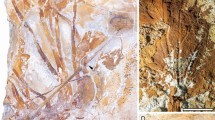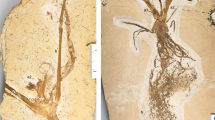Abstract
Archaeopteris is an extinct plant which is of botanical interest for two reasons. It was the main component of the earliest forests until its extinction around the Devonian/Carboniferous boundary1,3, and phylogenetically, it is the free-sporing taxon that shares the most characteristics with the seed plants4,5. Here we describe the largest group of anatomically preserved Archaeopteris remains ever found, from the Famennian marine beds of south-eastern Morocco6, and provide the first evidence that, in terms of development and branching strategies, these 370-million-year-old plants were the earliest known modern trees. This modernization involved the evolution of four characteristics: a lateral branching syndrome similar to the axillary branching of early seed plants; adventitious latent primordia similar to those produced by living trees, which eventually develop into roots on stem cuttings; nodal zones as important sites for the subsequent development of lateral organs; and wood anatomy strategies that minimize the mechanical stresses caused by perennial branch growth.
This is a preview of subscription content, access via your institution
Access options
Subscribe to this journal
Receive 51 print issues and online access
$199.00 per year
only $3.90 per issue
Buy this article
- Purchase on Springer Link
- Instant access to full article PDF
Prices may be subject to local taxes which are calculated during checkout

Similar content being viewed by others
References
Fairon-Demaret, M. Some uppermost Devonian megafloras: a stratigraphical review. Ann. Soc. Géol. Belgique 109, 43–48 (1986).
Beerbower, R. et al. in Terrestrial Ecosystems Through Time (ed. Behrensmeyer, A. K.) 205–325 (Univ. of Chicago Press, Chicago, 1992).
Scheckler, S. E. Geology, floristics, and paleoecology of Late Devonian coal swamps from Appalachian Laurentia (U.S.A.). Ann. Soc. Géol. Belgique 109, 209–222 (1986).
Rothwell, G. W. & Serbet, R. Lignophyte phylogeny and the evolution of spermatophytes: a numerical cladistic analysis. Syst. Bot. 19, 443–482 (1994).
Nixon, K. C., Crepet, W. L., Stevenson, D. & Friis, E. M. Areevaluation of seed plant phylogeny. Ann. Missouri Bot. Gard. 81, 484–533 (1994).
Wendt, J. & Belka, Z. Age and depositional environment of Upper Devonian (Early Frasnian to Early Famennian) black shales and limestones (Kellwasser facies) in the eastern-Anti-Atlas, Morocco. Facies 25, 51–90 (1991).
Beck, C. B. & Wight, D. C. in Origin and Evolution of Gymnosperms (ed. Beck, C. B.) 1–84 (Columbia University Press, New York, 1988).
Beck, C. B. On the anatomy and morphology of lateral branch systems of Archaeopteris. Am. J. Bot. 58, 758–784 (1971).
Carluccio, L. M., Hueber, F. M. & Banks, H. P. Archaeopteris macilenta, anatomy and morphology of its front. Am. J. Bot. 53, 719–730 (1966).
Kenrick, P. & Fairon-Demaret, M. Archaeopteris roemeriana (Göppert) sensu Stockmans, 1948 from the Upper Famennian of Belgium: anatomy and leaf polymorphism. Bull. Inst. R. Sci. Nat. Belgique, Sci. Terre 61, 179–195 (1991).
Scheckler, S. E. Ontogeny of progymnosperms. II. Shoots of Upper Devonian Archaeopteridales. Can. J. Bot. 56, 3136–3170 (1978).
Galtier, J. & Holmes, J. New observations on the branching of Carboniferous ferns and pteridosperms. Ann. Bot. 49, 737–746 (1982).
Trivett, M. L. An architectural analysis of Archaeopteris, a fossil tree with pseudomonopodial and opportunistic adventitious growth. Bot. J. Linn. Soc. 111, 301–329 (1993).
Meyer-Berthaud, B., Wendt, J. & Galtier, J. First record of a large Callixylon trunk from the Late Devonian of Gondwana. Geol. Mag. 134, 847–853 (1997).
Fink, S. Adventitious root primordia — The cause of abnormally broad xylem rays in hardwood and softwoods. IAWA Bull. n.s. 3, 31–38 (1982).
Larson, P. R. The Vascular Cambium: Development and Structure 1–725 (Springer, Berlin, 1994).
Mattheck, C. & Kubler, H. Wood — The Internal Optimization of Trees 1–129 (Springer, Berlin, 1995).
Zobel, B. J. & van Buijtenen, J. P. Wood Variation: its Causes and Control 1–363 (Springer, Berlin, 1989).
Acknowledgements
Portions of this study were supported by a sabbatical research leave from VPI & SU and a grant from the National Science Foundation (USA), Division of Integrative Biology and Neuroscience, Program for Ecological and Evolutionary Physiology (to S.E.S.). We thank M. Boutaleb and A. Fadile for the issue of working permits and the export of samples; S.Doering, R. Feist, B. Kaufmann, C. Klug and D.Korn for advice in the field; and J. Guiraud and L.Meslin for technical help. This work was supported by grants from IGCP (North Gondwanan mid-Palaeozoic biodynamics) and CNRS.
Author information
Authors and Affiliations
Corresponding author
Rights and permissions
About this article
Cite this article
Meyer-Berthaud, B., Scheckler, S. & Wendt, J. Archaeopteris is the earliest known modern tree. Nature 398, 700–701 (1999). https://doi.org/10.1038/19516
Received:
Accepted:
Issue Date:
DOI: https://doi.org/10.1038/19516
This article is cited by
-
The expansion of land plants during the Late Devonian contributed to the marine mass extinction
Communications Earth & Environment (2023)
-
Fossil evidence of tylosis formation in Late Devonian plants
Nature Plants (2023)
-
From tree to architecture: how functional morphology of arborescence connects plant biology, evolution and physics
Palaeobiodiversity and Palaeoenvironments (2021)
Comments
By submitting a comment you agree to abide by our Terms and Community Guidelines. If you find something abusive or that does not comply with our terms or guidelines please flag it as inappropriate.



